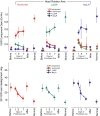Directional plasticity rapidly improves 3D vestibulo-ocular reflex alignment in monkeys using a multichannel vestibular prosthesis
- PMID: 24013822
- PMCID: PMC3825024
- DOI: 10.1007/s10162-013-0413-0
Directional plasticity rapidly improves 3D vestibulo-ocular reflex alignment in monkeys using a multichannel vestibular prosthesis
Abstract
Bilateral loss of vestibular sensation can be disabling. We have shown that a multichannel vestibular prosthesis (MVP) can partly restore vestibular sensation as evidenced by improvements in the 3-dimensional angular vestibulo-ocular reflex (3D VOR). However, a key challenge is to minimize misalignment between the axes of eye and head rotation, which is apparently caused by current spread beyond each electrode's targeted nerve branch. We recently reported that rodents wearing a MVP markedly improve 3D VOR alignment during the first week after MVP activation, probably through the same central nervous system adaptive mechanisms that mediate cross-axis adaptation over time in normal individuals wearing prisms that cause visual scene movement about an axis different than the axis of head rotation. We hypothesized that rhesus monkeys would exhibit similar improvements with continuous prosthetic stimulation over time. We created bilateral vestibular deficiency in four rhesus monkeys via intratympanic injection of gentamicin. A MVP was mounted to the cranium, and eye movements in response to whole-body passive rotation in darkness were measured repeatedly over 1 week of continuous head motion-modulated prosthetic electrical stimulation. 3D VOR responses to whole-body rotations about each semicircular canal axis were measured on days 1, 3, and 7 of chronic stimulation. Horizontal VOR gain during 1 Hz, 50 °/s peak whole-body rotations before the prosthesis was turned on was <0.1, which is profoundly below normal (0.94 ± 0.12). On stimulation day 1, VOR gain was 0.4-0.8, but the axis of observed eye movements aligned poorly with head rotation (misalignment range ∼30-40 °). Substantial improvement of axis misalignment was observed after 7 days of continuous motion-modulated prosthetic stimulation under normal diurnal lighting. Similar improvements were noted for all animals, all three axes of rotation tested, for all sinusoidal frequencies tested (0.05-5 Hz), and for high-acceleration transient rotations. VOR asymmetry changes did not reach statistical significance, although they did trend toward slight improvement over time. Prior studies had already shown that directional plasticity reduces misalignment when a subject with normal labyrinths views abnormal visual scene movement. Our results show that the converse is also true: individuals receiving misoriented vestibular sensation under normal viewing conditions rapidly adapt to restore a well-aligned 3D VOR. Considering the similarity of VOR physiology across primate species, similar effects are likely to occur in humans using a MVP to treat bilateral vestibular deficiency.
Figures








Similar articles
-
Restoration of 3D vestibular sensation in rhesus monkeys using a multichannel vestibular prosthesis.Hear Res. 2011 Nov;281(1-2):74-83. doi: 10.1016/j.heares.2011.08.008. Epub 2011 Aug 26. Hear Res. 2011. PMID: 21888961 Free PMC article.
-
Cross-axis adaptation improves 3D vestibulo-ocular reflex alignment during chronic stimulation via a head-mounted multichannel vestibular prosthesis.Exp Brain Res. 2011 May;210(3-4):595-606. doi: 10.1007/s00221-011-2591-5. Epub 2011 Mar 4. Exp Brain Res. 2011. PMID: 21374081 Free PMC article.
-
Multichannel vestibular prosthesis employing modulation of pulse rate and current with alignment precompensation elicits improved VOR performance in monkeys.J Assoc Res Otolaryngol. 2013 Apr;14(2):233-48. doi: 10.1007/s10162-013-0370-7. Epub 2013 Jan 26. J Assoc Res Otolaryngol. 2013. PMID: 23355001 Free PMC article.
-
Progress toward development of a multichannel vestibular prosthesis for treatment of bilateral vestibular deficiency.Anat Rec (Hoboken). 2012 Nov;295(11):2010-29. doi: 10.1002/ar.22581. Epub 2012 Oct 8. Anat Rec (Hoboken). 2012. PMID: 23044664 Free PMC article. Review.
-
Current and future management of bilateral loss of vestibular sensation - an update on the Johns Hopkins Multichannel Vestibular Prosthesis Project.Cochlear Implants Int. 2010 Sep;11 Suppl 2(Suppl 2):2-11. doi: 10.1179/146701010X12726366068454. Cochlear Implants Int. 2010. PMID: 21756683 Free PMC article. Review.
Cited by
-
The Next Challenges of Vestibular Implantation in Humans.J Assoc Res Otolaryngol. 2023 Aug;24(4):401-412. doi: 10.1007/s10162-023-00906-1. Epub 2023 Jul 29. J Assoc Res Otolaryngol. 2023. PMID: 37516679 Free PMC article. Review.
-
Vestibular implantation and longitudinal electrical stimulation of the semicircular canal afferents in human subjects.J Neurophysiol. 2015 Jun 1;113(10):3866-92. doi: 10.1152/jn.00171.2013. Epub 2015 Feb 4. J Neurophysiol. 2015. PMID: 25652917 Free PMC article.
-
[Current status and new progress of vestibular assistant systems].Lin Chuang Er Bi Yan Hou Tou Jing Wai Ke Za Zhi. 2020 Mar;34(3):285-288. doi: 10.13201/j.issn.2096-7993.2020.03.025. Lin Chuang Er Bi Yan Hou Tou Jing Wai Ke Za Zhi. 2020. PMID: 32791603 Free PMC article. Review. Chinese.
-
Binocular 3D otolith-ocular reflexes: responses of chinchillas to prosthetic electrical stimulation targeting the utricle and saccule.J Neurophysiol. 2020 Jan 1;123(1):259-276. doi: 10.1152/jn.00883.2018. Epub 2019 Nov 20. J Neurophysiol. 2020. PMID: 31747349 Free PMC article.
-
Bilateral Vestibular Deficiency: Quality of Life and Economic Implications.JAMA Otolaryngol Head Neck Surg. 2014 Jun;140(6):527-34. doi: 10.1001/jamaoto.2014.490. JAMA Otolaryngol Head Neck Surg. 2014. PMID: 24763518 Free PMC article.
References
-
- Carey JP, Della Santina CC. Principles of applied vestibular physiology. In: Flint P, editor. Cummings otolaryngology: head and neck surgery. Amsterdam: Elsevier; 2010.
Publication types
MeSH terms
Grants and funding
LinkOut - more resources
Full Text Sources
Other Literature Sources
Medical
Miscellaneous

